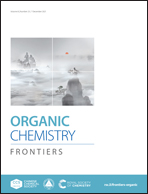Multifunctional P-ligand-controlled “silicon-centered” selectivity in Rh/Cu-catalyzed Si–C bond cleavage of silacyclobutanes†
Abstract
Silicon/carbon switching strategy, known as silasubstitution, plays an important role in drug discovery and material science. However, there is a dearth of efficient and precisely controlled methods for the introduction of a silicon center on complex molecules, which limits advances in the development of silicon-containing drug-like molecules. Here, we disclose an unprecendented process for the synthesis of six-membered functional silacycles based on multifunctional phosphine-promoted bimetallic Rh/Cu-catalyzed Si–C bond activation. The corresponding (4 + 2) annulation reaction chemoselectively and smoothly generates a wide range of monoester-functional silacyclohexenes. And it was found that only our newly developed Ar-BINMOL-Phos bearing a P-center and two hydroxyl groups exhibited perfect chemoselectivity with the aid of the cooperation of rhodium and copper co-catalysts, in which the Rh/Cu co-catalyzed (4 + 2) annulation of silacyclobutanes with arylpropiolate-type internal alkynes led to a facile synthesis of structurally diverse 1-sila-2-cyclohexenes with moderate to good yields. And with a chiral Ar-BINMOL-Phos bearing 3,5-tert-butyl substitutions on the aryl ring as a chiral P-ligand, good enantioselectivity at the “silicon-center” point chirality of the desired silicon-stereogenic silacycles was achieved under the cooperative catalysis of rhodium and copper.



 Please wait while we load your content...
Please wait while we load your content...